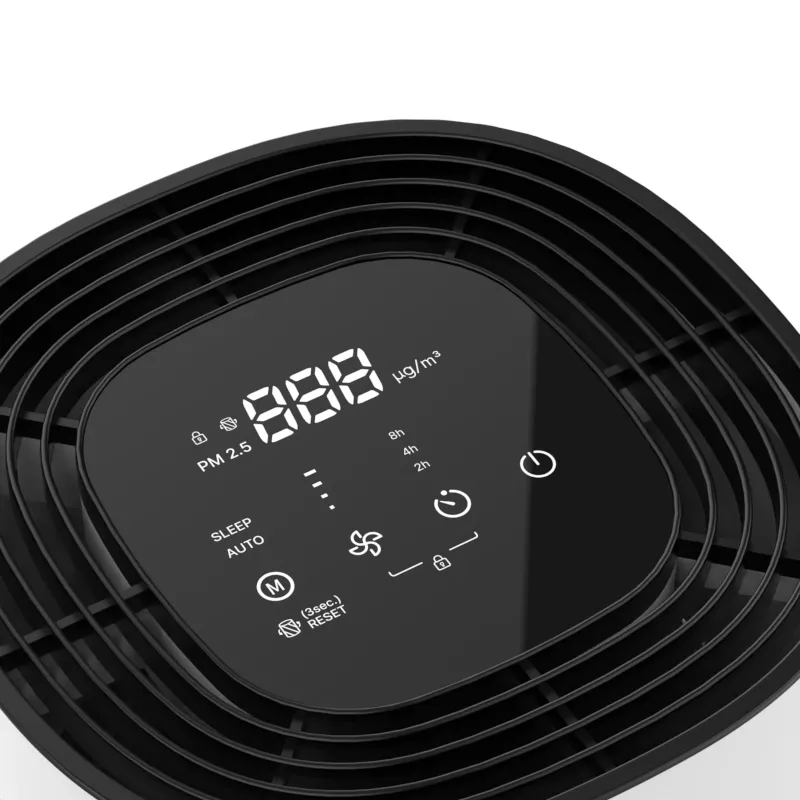एयर प्यूरीफायर आपके घर से कौन-से प्रदूषकों को हटा सकता है?
सामान्य आंतरिक वायु प्रदूषकों और उनके स्वास्थ्य पर प्रभाव की जानकारी
हमारे घरों के अंदर की हवा बाहर की हवा की तुलना में काफी अधिक प्रदूषित हो सकती है, जिसमें स्वास्थ्य और कल्याण को प्रभावित करने वाले वायुवाहित प्रदूषकों का एक जटिल मिश्रण होता है। आधुनिक वायु शोधक इन अदृश्य खतरों से निपटने के लिए आवश्यक उपकरण बन गए हैं, जो हमारे आंतरिक स्थानों में जमा होने वाले विभिन्न प्रदूषकों को प्रभावी ढंग से हटा देते हैं। चूंकि हम अपने समय का लगभग 90% भाग आंतरिक स्थानों में बिताते हैं, इसलिए यह जानना हवा शोधक प्रदूषकों को खत्म किया जा सकता है, जो एक स्वस्थ जीवन पर्यावरण बनाए रखने के लिए महत्वपूर्ण है।
आंतरिक वायु प्रदूषकों की प्राथमिक श्रेणियाँ
कणिका पदार्थ और धूल
वायु शोधक उपकरणों द्वारा लक्षित किए जाने वाले प्रदूषकों के सबसे सामान्य प्रकारों में से एक कणिका पदार्थ है। इस श्रेणी में धूल, गंदगी और हवा में तैरने वाले अन्य सूक्ष्म कण शामिल हैं। ये कण दिखाई देने वाले धूल के गुच्छों से लेकर 2.5 माइक्रॉन व्यास (PM2.5) से कम के सूक्ष्म कणों तक आकार में भिन्न होते हैं। उच्च दक्षता वाले वायु शोधक 0.3 माइक्रॉन जितने छोटे कणों को भी पकड़ सकते हैं, जो इसलिए विशेष रूप से महत्वपूर्ण है क्योंकि ये छोटे कण हमारे फेफड़ों में गहराई तक प्रवेश कर सकते हैं।
धूल के कीड़े, पराग और पालतू जानवरों के छिलके भी इस श्रेणी में आते हैं। ये एलर्जीकर्ता श्वसन संवेदनशीलता या एलर्जी वाले व्यक्तियों के लिए विशेष रूप से परेशानी वाले होते हैं। HEPA फिल्टर से लैस गुणवत्तापूर्ण वायु शोधक इनमें से 99.97% तक कणों को हटा सकते हैं, जिससे आंतरिक वायु गुणवत्ता में महत्वपूर्ण सुधार होता है और एलर्जी के लक्षण कम होते हैं।
उष्णकटिबंधीय कार्बनिक यौगिक (वीओसी)
वाष्पशील जैविक यौगिक (वीओसी) वायु शोधक प्रदूषकों का एक महत्वपूर्ण वर्ग हैं जिसे कई आधुनिक उपकरणों द्वारा दूर करने के लिए डिज़ाइन किया गया है। ये रसायन कुछ ठोस या तरल पदार्थों से गैस के रूप में उत्सर्जित होते हैं और अल्पकालिक एवं दीर्घकालिक स्वास्थ्य प्रभाव उत्पन्न करने वाले विभिन्न रसायनों को शामिल करते हैं। वीओसी के सामान्य स्रोतों में घरेलू सफाई उत्पाद, पेंट, नई फर्नीचर और निर्माण सामग्री शामिल हैं।
सक्रिय कार्बन फिल्टर वाले उन्नत वायु शोधक अधिशोषण के माध्यम से वीओसी को हटाने में विशेष रूप से प्रभावी होते हैं। यह प्रक्रिया कार्बन की संरचना में इन गैसीय प्रदूषकों को फंसा देती है, जिससे आपके घर की वायु में उनके पुनः संचरण को रोका जा सके। इनमें से कुछ सबसे आम वीओसी जिन्हें हटाया जाता है, उनमें फॉर्मेलडिहाइड, बेंजीन और टॉल्यूइन शामिल हैं।

जैविक संदूषक और सूक्ष्मजीव
जीवाणु और वायरस
आधुनिक वायु शोधक जैविक वायु शोधक प्रदूषकों से निपटने की अपनी क्षमता में लगातार अधिक परिष्कृत होते जा रहे हैं। यूवी-सी प्रकाश और प्रकाश उत्प्रेरित ऑक्सीकरण जैसी उन्नत तकनीकों का उपयोग करके, ये उपकरण हानिकारक सूक्ष्मजीवों को प्रभावी ढंग से निष्क्रिय कर सकते हैं। बैक्टीरिया और वायरस जो आमतौर पर आंतरिक वायु में घूमते हैं, उन्हें नष्ट किया जा सकता है, जिससे वायु द्वारा फैलने वाले संक्रमणों और श्वसन रोगों के जोखिम को कम किया जा सकता है।
इन जैविक संदूषकों के खिलाफ वायु शोधक की प्रभावशीलता अधिकांशतः इस्तेमाल की गई विशिष्ट तकनीकों पर निर्भर करती है। वास्तविक हेपा फिल्टर युक्त इकाइयाँ जो यूवी-सी प्रकाश के साथ संयुक्त होती हैं, दोहरी दृष्टिकोण प्रदान करती हैं: सूक्ष्मजीवों को भौतिक रूप से फंसाना और फिर यूवी विकिरण के माध्यम से उन्हें नष्ट करना।
फफूंदी के स्पोर और कवक
फफूंद के स्पोर जैविक एयर प्यूरीफायर प्रदूषकों की एक अन्य श्रेणी का प्रतिनिधित्व करते हैं जिन्हें ये उपकरण प्रभावी ढंग से हटा सकते हैं। ये सूक्ष्म कण विशेष रूप से एलर्जी या कमजोर प्रतिरक्षा प्रणाली वाले व्यक्तियों में गंभीर स्वास्थ्य समस्याएं पैदा कर सकते हैं। विशेष फिल्टर वाले एयर प्यूरीफायर आपके घर के नम क्षेत्रों में फफूंद के स्पोर के बसने और बढ़ने से पहले उन्हें पकड़ सकते हैं।
फफूंद के लिए सबसे प्रभावी एयर प्यूरीफायर HEPA फिल्ट्रेशन को सक्रिय कार्बन फिल्टर के साथ जोड़ते हैं, क्योंकि यह संयोजन फफूंद के स्पोरों के साथ-साथ फफूंद के विकास से जुड़ी सड़ी गंध का भी सामना कर सकता है। कुछ उन्नत मॉडल नमी सेंसर को भी शामिल करते हैं ताकि उपयोगकर्ताओं को तब चेतावनी दी जा सके जब स्थितियां फफूंद के विकास के लिए अनुकूल हो जाएं।
रासायनिक प्रदूषक और गैसें
कार्बन मोनोऑक्साइड और अन्य हानिकारक गैसें
जबकि वायु शोधक कार्बन मोनोऑक्साइड (CO) के खिलाफ प्राथमिक सुरक्षा तंत्र नहीं हैं, कई उन्नत मॉडल आपके घर में विभिन्न हानिकारक गैसों के स्तर को कम करने में मदद कर सकते हैं। इन वायु शोधक प्रदूषकों में गैस स्टोव से नाइट्रोजन डाइऑक्साइड, इलेक्ट्रॉनिक उपकरणों से ओजोन और अन्य गैसीय प्रदूषक शामिल हैं जो आंतरिक रूप से जमा हो सकते हैं।
उन्नत गैस-चरण फ़िल्ट्रेशन प्रणाली से लैस विशेष वायु शोधक इन रासायनिक प्रदूषकों को प्रभावी ढंग से हटा सकते हैं। हालाँकि, यह ध्यान रखना महत्वपूर्ण है कि व्यापक सुरक्षा के लिए इनका उपयोग उचित वेंटिलेशन और समर्पित कार्बन मोनोऑक्साइड डिटेक्टर के साथ संयोजन में किया जाना चाहिए।
धुआं और तंबाकू के कण
धुएं के कण, चाहे वे तंबाकू, खाना पकाने या बाहरी स्रोतों से हों, वायु शोधक प्रदूषकों में से कुछ सबसे व्यापक हैं। ये कण विशेष रूप से चुनौतीपूर्ण हैं क्योंकि इनमें कणिका पदार्थ और गैसीय प्रदूषक दोनों शामिल होते हैं। उच्च-गुणवत्ता वाले वायु शोधक दोनों घटकों को प्रभावी ढंग से दूर करने के लिए बहु-स्तरीय फ़िल्ट्रेशन प्रणाली का उपयोग करते हैं।
धूम्रपान को हटाने के लिए सबसे प्रभावी उपकरण कणों के लिए HEPA फ़िल्टरेशन और गैसीय घटकों तथा गंध के लिए सक्रिय कार्बन फ़िल्टर को जोड़ते हैं। धूम्रपान से संबंधित प्रदूषकों को व्यापक रूप से हटाने और संबंधित गंध को खत्म करने में इस दोहरे दृष्टिकोण से सहायता मिलती है।
वायु शोधन में उभरती प्रौद्योगिकियाँ
उन्नत फ़िल्टरेशन विधियाँ
वायु शोधन का क्षेत्र लगातार विकसित हो रहा है, जिसमें वायु शोधक प्रदूषकों से निपटने के लिए अधिक प्रभावी ढंग से नई प्रौद्योगिकियों का उदय हो रहा है। हाल की नवाचारों में प्लाज्मा फ़िल्टरेशन, आणविक छलनी प्रौद्योगिकी और उन्नत प्रकाश उत्प्रेरित ऑक्सीकरण प्रणाली शामिल हैं। ये प्रौद्योगिकियाँ आंतरिक वायु से यहां तक कि सबसे ज़्यादा ज़िद्दी प्रदूषकों को हटाने के लिए बढ़ी हुई क्षमता प्रदान करती हैं।
आधुनिक वायु शोधकों में स्मार्ट सेंसर और कृत्रिम बुद्धिमत्ता को भी एकीकृत किया जा रहा है, जो उन्हें प्रदूषक स्तर के आधार पर स्वचालित रूप से अपना संचालन समायोजित करने की अनुमति देता है। इससे उत्कृष्ट वायु गुणवत्ता बनाए रखते हुए इष्टतम प्रदर्शन और ऊर्जा दक्षता सुनिश्चित होती है।
स्मार्ट एकीकरण और निगरानी
आधुनिक एयर प्यूरीफायर में लगातार स्मार्ट सुविधाएं जोड़ी जा रही हैं, जो उपयोगकर्ताओं को अपनी आंतरिक वायु गुणवत्ता की दूर से निगरानी और नियंत्रण करने की अनुमति देती हैं। ये उन्नत प्रणाली आपके घर में मौजूद विभिन्न एयर प्यूरीफायर प्रदूषकों के बारे में वास्तविक समय के आंकड़े प्रदान कर सकती हैं, जिससे वायु गुणवत्ता प्रबंधन के बारे में अधिक जानकारी वाले निर्णय लेने में मदद मिलती है।
कनेक्टेड उपकरण समय के साथ प्रदूषण रुझानों को ट्रैक कर सकते हैं, वायु गुणवत्ता के आधार पर स्वचालित रूप से फ़िल्टरेशन स्तर को समायोजित कर सकते हैं, और यह भी भविष्यवाणी कर सकते हैं कि फ़िल्टर के प्रतिस्थापन की आवश्यकता कब होगी। इस स्तर का नियंत्रण और निगरानी आंतरिक वायु प्रदूषकों के खिलाफ लगातार सुरक्षा सुनिश्चित करने में मदद करता है।
अक्सर पूछे जाने वाले प्रश्न
मुझे अपने एयर प्यूरीफायर के फ़िल्टर को कितनी बार प्रतिस्थापित करना चाहिए?
फिल्टर के प्रतिस्थापन की आवृत्ति कई कारकों पर निर्भर करती है, जिसमें आपके क्षेत्र में फिल्टर का प्रकार, वायु गुणवत्ता और उपयोग प्रतिरूप शामिल हैं। आम तौर पर, हेपा फिल्टर को 6-12 महीने में बदल देना चाहिए, जबकि सक्रिय कार्बन फिल्टर को 3-6 महीने में बदलने की आवश्यकता हो सकती है। हमेशा निर्माता की सिफारिशों का पालन करें और यदि आपके उपकरण में फिल्टर स्थिति संकेतक हैं, तो उनकी निगरानी करें।
क्या एयर प्यूरीफायर खाना पकाने की गंध और धुएं को हटा सकते हैं?
हां, सक्रिय कार्बन फिल्टर से लैस एयर प्यूरीफायर खाना पकाने की गंध और धुएं को हटाने में विशेष रूप से प्रभावी होते हैं। सक्रिय कार्बन गैसीय प्रदूषकों और गंध अणुओं का अधिशोषण करता है, जबकि हेपा फिल्टर धुएं के कणों को पकड़ते हैं। सर्वोत्तम परिणामों के लिए, उस इकाई का चयन करें जो गंध और धुआं निकालने के लिए विशेष रूप से डिज़ाइन की गई हो।
मेरे स्थान के लिए मुझे कितने आकार के एयर प्यूरीफायर की आवश्यकता है?
उपयुक्त आकार आपके कमरे के आयामों और वायु परिवर्तन आवश्यकताओं पर निर्भर करता है। स्वच्छ वायु वितरण दर (CADR) रेटिंग की जाँच करें और उस इकाई का चयन करें जो आपके कमरे के आकार को संभाल सके। एक सामान्य नियम यह है कि अधिकतम प्रभावशीलता के लिए प्रति घंटे कमरे की वायु मात्रा को कम से कम 4-5 बार संसाधित करने में सक्षम एक वायु शोधक का चयन करें।

 EN
EN
 AR
AR
 NL
NL
 FR
FR
 DE
DE
 EL
EL
 HI
HI
 IT
IT
 JA
JA
 KO
KO
 PL
PL
 PT
PT
 ES
ES
 ID
ID
 VI
VI
 TH
TH
 TR
TR
 MS
MS
